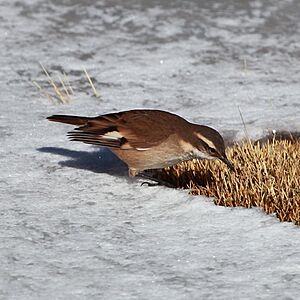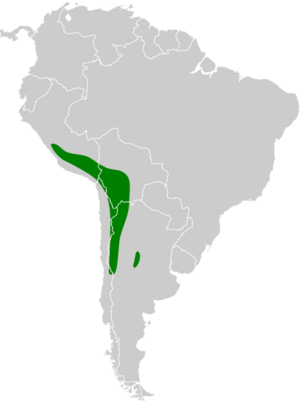White-winged cinclodes facts for kids
Quick facts for kids White-winged cinclodes |
|
|---|---|
 |
|
| White-winged cinclodes at San Pedro de Atacama, Antofagasta Region, Chile | |
| Conservation status | |
| Scientific classification | |
| Genus: |
Cinclodes
|
| Species: |
atacamensis
|
 |
|
The white-winged cinclodes (Cinclodes atacamensis) is a cool bird that lives in parts of South America. It's a type of ovenbird, which is a family of birds known for their interesting nests. You can find this bird in countries like Argentina, Bolivia, Chile, and Peru.
Contents
What's in a Name? (Taxonomy)
Birds, like all living things, have scientific names. This helps scientists around the world know exactly which animal they are talking about! The white-winged cinclodes has two main types, called subspecies. Think of them like different versions of the same bird. These are C. a. atacamensis and C. a. schocolatinus.
What Does It Look Like?
The white-winged cinclodes is about 19 to 20 centimeters (7.5 to 8 inches) long. It weighs around 45 to 56 grams (1.6 to 2 ounces). This bird is fairly large for a cinclodes, and its beak curves downwards. Both male and female birds look the same.
Feathers and Colors
This bird has a whitish stripe above its eye. Its face is brownish-gray with reddish hints. The top of its head is grayish-brown, and its back is a rich reddish-brown color.
Wings and Tail
Its wings have a cool white patch that stands out when it flies. The main flight feathers are dark, but they have white at their base, forming a clear band. The tail feathers are dark brown, with white spots that get bigger on the outer feathers.
Belly and Legs
The throat is whitish with tiny dark spots. Its chest and sides are grayish, and its belly is brownish-gray. The legs and feet are dark brown. Young birds look similar to adults but have paler edges on their lower back feathers.
Subspecies Differences
The C. a. schocolatinus subspecies looks a bit different. It has darker brown feathers on its back and grayer feathers underneath. Its sides are also a darker brown.
Where Does It Live? (Distribution and Habitat)
The white-winged cinclodes lives in different parts of South America. The C. a. atacamensis subspecies is found from central Peru, south through western Bolivia, to Chile and northwest Argentina. The C. a. schocolatinus subspecies lives in west-central Argentina.
Favorite Places
This bird loves to live in high grasslands called puna grasslands. It also likes rocky or bushy slopes. You will almost always find it near flowing streams and rivers. It usually lives at high elevations, mostly between 2,800 and 4,500 meters (9,200 and 14,800 feet) above sea level. Sometimes, it can be found as low as 2,200 meters (7,200 feet).
How Does It Behave?
Movement
Most white-winged cinclodes birds stay in the same area all year round. However, some birds, especially those from the southernmost areas, might move to lower places after they have their babies.
What Does It Eat? (Feeding)
This bird's diet includes insects, spiders, and snails. It usually looks for food alone or in pairs. It picks up its prey from the ground and mud right next to streams and rivers.
How Does It Make Babies? (Reproduction)
The white-winged cinclodes likely has its babies during the spring and summer months in the southern hemisphere, from October to December. They are thought to stay with one partner.
Nests and Eggs
They build their nests in a special chamber at the end of a tunnel. They dig these tunnels in dirt banks, or sometimes use cracks in rocks or even walls of human buildings. They line the bottom of the nest chamber with dry grass and hair to make it cozy. A female bird usually lays two eggs. Scientists don't know exactly how long the eggs take to hatch or when the young birds leave the nest.
What Does It Sound Like? (Vocalization)
The song of the white-winged cinclodes is a fast, vibrating sound called a trill. Its call is a loud, clear whistle that sounds like "wheet."
Is It Safe? (Status)
The IUCN (a group that checks on animals) says the white-winged cinclodes is a species of "Least Concern." This means it's not currently in danger of disappearing. It lives in a very large area, but its total number of birds is not known and might be going down. There are no big threats to this bird right now. It's considered to be uncommon to fairly common. Because it lives in high, remote places, it's pretty safe from most human activities, except for too much grazing by animals in its habitat.


